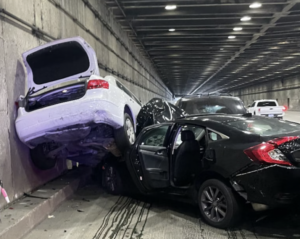Last November, footage of a Tesla electric vehicle (EV) was captured as it changed lanes traveling at roughly 55 mph, braked abruptly, and then slowed to 20 mph resulting in an eight-car pile-up that snarled traffic on the San Francisco Bay Bridge for over an hour. According to the driver, the vehicle was using new feature of “full self-driving” mode, which brings the safety and/or problems with self-driving cars into discussion.
While no one was killed or seriously injured in the accident, there were numerous injuries to drivers and passengers that included head trauma sustained by a two-year-old child who required hospitalization.

The accident also raises more questions about exactly how viable and safe the “self-driving” feature is in vehicles. The National Highway Traffic Safety Administration (NHTSA) launched an investigation of the crash. Between July 2021 and June 2022, the agency recorded 392 accidents where advanced driver assistance systems were engaged or involved.
What does “advanced driver assistance systems” and “self-driving” really mean?
Vehicles that incorporate systems that offer some level of automation utilize software programming that allows the vehicle’s system to perform a variety functions. These functions vary depending on the model and make of the vehicle.
A number of newer vehicles are equipped with systems that are designed to detect objects that are too close to the vehicle and then either automatically reduce the speed of the vehicle or activate the braking system to avoid a collision. Many also offer auto-park functions that allow the vehicle to parallel or perpendicularly park itself when engaged.
In the Tesla models that offer the enhanced autopilot feature, there is a range of functions. When engaged, the basic autopilot system is designed to maintain a set speed, stay within the lane of traffic, keep a safe distance, and even change lanes. It also includes auto-park and a “summon” and “smart summon” functions. The “summon” and “smart summon” functions allow the vehicle to come find the driver while navigating parking lots, avoiding obstacles and still obeying traffic signs.
The expanded feature of “Full Self-Driving” mode
“Full Self-Driving” mode is designed to recognize and respond to stop signs and other traffic signals. The additional features of be able to navigate city and residential streets and making turns are promised as “coming soon” in availability on the Tesla website but is available in beta testing on some vehicles. All of these functions also rely on over-the-air software updates.
What these systems are not designed to do is operate completely autonomously and without the driver of the vehicle paying close attention and being prepared to immediately resume full control of the vehicle at all times.
The entire point of automated features on vehicles is supposed to be making driving safer for everyone—drivers, passengers, and even pedestrians.
There have been a number of reported problems with self-driving cars and Tesla vehicles that range from problems with “phantom braking” where the car engages the braking system for no apparent reason to batteries failing to charge in cold temperatures to failure of the touchscreen computer screen. Other complaints revolve around poor customer service, expensive maintenance costs, and frequent software updates that are designed to fix bugs but often initially make the software issues worse.
New cars are expensive, and as consumers, we expect to get what we paid for—a vehicle that runs properly, is efficient, and complies with safety standards. If you have purchased or leased a new vehicle that has exhibited defects or conditions that cannot be remedied by the dealership in a reasonable amount of time, you may qualify for relief under your state’s Lemon Law. SUBMIT YOUR INFORMATION HERE for a FREE Lemon Law Review to see if you qualify.

